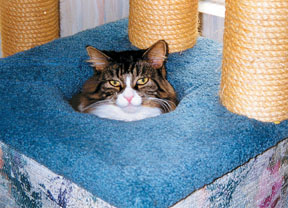
288
Your cat comes to the door to greet you, rubs around your legs, purrs when you pet her and cuddles next to you on the couch. But if a friend comes to visit, a car backfires outside or if a strange cat prowls outside the house, your frightened feline is gone. Then the search begins for her – under the bed, inside a closet, down in the basement – or maybe even on top of the refrigerator. What makes some cats so afraid even in the safety of their homes? There are a number of reasons and some simple things you can do to calm down your nervous cat.
What Creates a Scaredy Cat?
Some fear of unfamiliar things – noises, people – is natural for cats and all other animals, including humans. Getting appropriately scared makes evolutionary sense, says Katherine Houpt, VMD, PhD, director of the animal behavior clinic of the College of Veterinary Medicine at Cornell University. It serves as a protection against possible danger. But a cat who hears someone at the door and runs and hides under the bed for three hours is experiencing excessive fear.
Generally, fearful cats are not outgoing or dont seem to display the spontaneous curiosity about things the way other cats do. Instead they will avoid new things, says Dr. Houpt. They will form bonds with their human companions, but they will run from new people. And they are often the scapegoats in multi-cat households.
You already know if you are living with a fearful cat. He will often hide or cower if something scares him. About 25 percent of cats are genetically fearful, says Dr. Houpt, who is board certified by the American College of Veterinary Behaviorists. Usually, their parents carry the genes for fearfulness and have passed them on to the kitten.
What happens in kittenhood – especially the period from two to seven weeks of age – can also make a difference. This is the period when cats acquire their social skills from interacting with their siblings and any human companions. According to Dr. Houpt, If a kitten is raised in an environment in which it isnt handled by humans and sees them only once a day, it is more likely to be fearful than a kitten born in a familys bedroom closet who is handled several times a day.
The more positive experiences a kitten has with other cats and humans, the more sociable and less fearful a cat will be. Experts warn that if a cat is removed from the mother and siblings before seven or eight weeks, the cat is more likely to exhibit fearfulness and other behavior problems in adult life.
Certain experiences can also lead to fearfulness in a cat. Consider the situation in which two cats live peacefully together in one household. One cat spots a strange feline outside the window, leaps at it but cant get to it. Then the cat turns to his housemate, redirecting his territorial frustration at this cat that starts running, says Dr. Houpt. This sets up a cycle of one cat chasing another household cat that then becomes fearful.
Another experience involves a cat that comes home after being at the veterinarian for a few days. The cat may smell different, be weaker as a result of illness or sedation – and the cats housemate may not recognize it and attack it. Again, a fearful situation is established.
Fear of the cat carrier with the association of going to the veterinarians office is a very common fear and one which you may regularly experience with your cat.
Treating Feline Fears
The treatment of choice in helping a fearful cat is usually desensitization – a behavioral approach in which the cat is slowly and incrementally introduced to the fearful object so the cat gradually becomes accustomed to it. A common example is the fear of strangers. You can ask a friend to come to the house and present himself to your cat at decreasing distances, as long as the cat remains calm. For example, he may approach the cat at 20 feet, then 12 feet, and then eight feet and so on. At each distance you give her a treat as she sits calmly, but not if she becomes frightened (signs to look for are ears flattened, pupils dilated). If you see signs of fear, you are progressing too quickly and should ask the friend to stop making progress.
Desensitization and other behavioral approaches are best handled with professional advice. Ask your veterinarian for instructions or seek the assistance of a board-certified animal behaviorist.
Occasionally veterinarians will give a fearful cat anti-anxiety medicine to help curb the fear, says Dr. Houpt. In the situation where one cats keeps running from a more aggressive cat in the house, I may give the fearful cat medicine to help him stop running. I may also give the aggressive cat medication to reduce aggression and, therefore, stop the chasing.
When Its a Human Problem
Sometimes the problem is not so much with the cat as with the human companions attitude, says Dr. Houpt. If you want to show off your cat to visitors and he runs and hides instead, that could be irritating, but not really a problem if he comes out shortly after the visitors leave, she says. Not all cats are social butterflies and you may need to accept your cats personality for what it is. But if your cat runs and hides for hours – and it becomes a quality of life issue – then you need to consult your veterinarian about helping your cat become less fearful.



